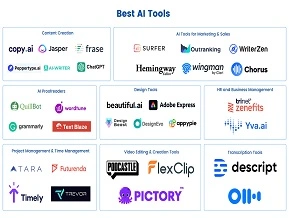Top 10 AI Testing Tools to Improve your Software Quality in 2025
1. Why are AI Testing Tools Critical for Software Quality in 2025?
The Growing Complexity of Software Development
In 2025, _AI testing tools_ have become indispensable due to the rising complexity of modern software applications. As software grows more feature-rich and integrates with various platforms and services, traditional manual testing struggles to keep up with the speed and scale required. This increasing complexity demands smarter, automated testing solutions that can handle diverse environments efficiently.
Enhancing Test Coverage and Reducing Manual Effort
AI testing tools help reduce the manual effort involved in creating and maintaining test cases. These tools can automatically generate, execute, and adapt tests based on application changes, significantly increasing test coverage. By leveraging machine learning algorithms, they identify the most critical paths to test, ensuring thorough validation with less human intervention.
Predicting Defects with Data-Driven Insights
One of the biggest advantages of combining testing tools and AI is their ability to analyse vast amounts of data from past test runs, code commits, and production incidents. This allows teams to predict defect-prone areas early in the development cycle, enabling proactive bug fixes and improving overall software reliability.
Driving Efficiency in Continuous Delivery Pipelines
In today’s fast-paced DevOps environments, continuous integration and delivery demand rapid, reliable testing. AI testing tools integrate seamlessly into these pipelines, running automated tests with high accuracy and consistency. This accelerates release cycles while maintaining high software quality standards, helping organizations stay competitive.
2. How Do Testing Tools and AI Work Together in Modern QA?
The Power of AI in Enhancing Traditional Testing Tools
AI testing tools are revolutionizing modern quality assurance by enhancing traditional testing methods with automation and intelligent capabilities. Instead of relying solely on manual test scripts, AI-powered tools bring smart automation that adapts and improves over time, making QA more efficient and effective.
Machine Learning for Smarter Test Optimization
By applying machine learning algorithms, these tools analyse historical test data to identify patterns in software behaviour and defects. This insight helps optimize test cases by prioritizing the most critical and failure-prone scenarios, reducing redundant tests, and focusing efforts where they matter most. This synergy between testing tools and AI leads to faster test cycles with better coverage.
Natural Language Processing for Smarter Test Creation
Natural Language Processing (NLP) capabilities in AI testing tools enable the understanding of human language in test case descriptions and requirements. This allows for smarter creation, interpretation, and even generation of test cases directly from documentation or user stories, bridging the gap between technical and non-technical teams.
Adaptive and Self-Healing Tests for Dynamic Software
One of the standout features of AI integration in testing tools is the ability to create adaptive and self-healing tests. As applications evolve with frequent UI and backend changes, AI-powered tests automatically adjust to these modifications without breaking. This reduces maintenance time and ensures continuous testing effectiveness, even in fast-changing environments.
3. What Features Should You Look for in AI Testing Tools?
AI-Powered Visual Testing for Accurate UI Validation
One of the standout features to look for in AI testing tools is visual testing powered by AI-driven object recognition. This technology enables precise identification and validation of UI elements, even when layouts or designs change slightly. It ensures that your application’s user interface looks and functions as expected across different devices and screen sizes, catching visual bugs that traditional tests might miss.
Predictive Analytics for Proactive Bug Detection
Predictive analytics is another critical feature that leverages historical data and machine learning to detect potential defects early in the development cycle. This capability helps teams focus their testing efforts on high-risk areas, reducing the time spent on less critical tests and increasing the chances of catching bugs before they reach production.
Test Optimization Using Machine Learning Algorithms
AI testing tools often use machine learning algorithms to optimize the testing process. They analyse past test results to identify redundant or low-value tests, and automatically prioritize test cases based on risk and impact. This results in more efficient testing cycles with better coverage, saving both time and resources.
Seamless Integration with CI/CD and DevOps Pipelines
In today’s agile and fast-paced development environments, AI testing tools must integrate smoothly with continuous integration and continuous delivery (CI/CD) pipelines. This integration enables automated, real-time testing during every code commit, ensuring that quality is maintained without slowing down delivery. The ability to plug into popular DevOps tools and workflows is essential for maximizing efficiency.
4. Which are the Top 10 AI Testing Tools to Consider in 2025?
Testim: AI-Powered Automation with Self-Healing Tests
Testim is a leading choice among AI testing tools for its robust AI-powered test automation platform. It features self-healing capabilities that allow tests to automatically adapt to changes in the application’s UI without breaking. This reduces maintenance overhead and helps teams deliver faster, more reliable software.
Applitools: Visual AI for UI Validation
Applitools specializes in visual AI testing, offering an advanced platform that uses AI-driven object recognition to validate the appearance and functionality of user interfaces. It detects visual bugs that traditional testing methods often miss, ensuring a seamless user experience across browsers and devices.
Mabl: Intelligent End-to-End Testing with Auto-Maintenance
Mabl provides an intelligent testing solution designed for end-to-end automation. With features like auto-maintenance, Mabl automatically updates tests when it detects changes in the application, reducing manual intervention. It also integrates well with popular CI/CD pipelines, enabling continuous testing and faster releases.
Fictionize: NLP-Driven Test Creation and Smart Analytics
Fictionize stands out by leveraging natural language processing (NLP) to simplify test creation. Test cases can be generated from plain English instructions, making it easier for non-technical team members to participate in testing. Additionally, Fictionize offers smart analytics that provide actionable insights to improve test effectiveness.
5. What are Some More Promising AI Testing Tools in the Market?
ACCELQ: Codeless Automation with AI and Cloud-Native Features
ACCELQ offers a powerful codeless automation platform that leverages AI to simplify test creation and execution. Its cloud-native architecture supports scalable testing environments and seamless collaboration. By using intelligent automation, ACCELQ helps teams accelerate testing cycles while reducing dependency on coding skills.
Katalon Studio: AI-Based Test Recommendations for Smarter Testing
Katalon Studio integrates AI to provide test recommendations, enhancing the testing process by suggesting relevant test cases and identifying redundant scripts. This capability enables QA teams to focus on high-impact areas, improving efficiency and test coverage. Katalon’s user-friendly interface also supports testers with varying experience levels.
Virtuoso: Autonomous Testing with NLP and Intelligent Locators
Virtuoso stands out by using natural language processing (NLP) combined with intelligent locators to create autonomous tests that adapt to application changes. This reduces maintenance efforts and enables testers to generate complex test scenarios using simple language commands, bridging the gap between technical and non-technical team members.
Test.ai: AI Bots for Cross-Platform Mobile App UI Testing
Test.ai deploys AI-powered bots designed specifically for mobile app UI testing across multiple platforms. These bots can mimic user interactions and automatically detect UI issues, providing extensive coverage without the need for manual scripting. This makes Test.ai an excellent choice for teams focused on mobile testing.
These promising AI testing tools reflect the ongoing innovation in quality assurance, offering a variety of features from codeless automation to AI-driven test suggestions. Incorporating these tools can help teams improve test accuracy, reduce manual workload, and accelerate delivery timelines—key advantages in today’s fast-paced software development landscape.
6. How Do These Testing Tools and AI Platforms Compare?
Levels of AI Maturity across Testing Tools
AI testing tools vary widely in their level of AI sophistication. Some focus on basic automation, such as scripted test execution and simple UI validations. Others leverage advanced AI techniques like deep learning to predict defects, optimize test suites, and enable self-healing capabilities. Understanding the AI maturity of each platform helps organizations choose the right tool that matches their testing complexity and goals.
Specialized Strengths: Visual Testing, NLP, and More
Different tools excel in distinct areas of testing. For example, some platforms lead in visual testing, using AI-powered object recognition to validate UI elements across devices and browsers. Others specialize in natural language processing (NLP) to simplify test creation and analysis, while some focus on predictive analytics to forecast performance and detect potential issues early. Choosing a tool that aligns with your primary testing needs can maximize efficiency and outcomes.
Diverse Cost Structures to Fit Various Budgets
Pricing models for AI testing tools vary significantly. Many offer freemium plans that allow small teams to get started with basic features. Larger enterprises may require advanced capabilities and scalability, which come with enterprise-level or custom pricing. It’s important to evaluate not only upfront costs but also ongoing maintenance and support expenses when selecting a tool.
Use-Case Suitability: Web, Mobile, API, and Cross-Platform
The suitability of an AI testing tool often depends on the type of application you’re testing. Some tools are optimized for web applications, while others focus on mobile apps or API testing. Cross-platform tools that support multiple environments can be valuable for organizations with diverse technology stacks. Assessing use-case compatibility ensures the tool integrates well with your existing workflows.
When comparing testing tools and AI platforms, carefully consider these factors to select the solution that best supports your software quality goals and team capabilities.
7. How Can You Choose the Right AI Testing Tool for Your Needs?
Assess Your Team’s Skill Level and Tech Stack Compatibility
Selecting the right AI testing tool begins with a clear understanding of your team’s technical expertise and the technology stack they use daily. It’s crucial to choose a tool that aligns with your team’s skills to ensure smooth adoption and minimize the learning curve. For example, a team proficient in scripting languages might prefer tools offering extensive customization through code, while less technical teams may benefit from user-friendly, no-code platforms. Additionally, compatibility with your existing tech stack—such as programming languages, frameworks, and testing environments—helps avoid integration challenges. A well-matched tool reduces friction during implementation and accelerates the overall testing process.
Define Your Testing Goals: Speed, Accuracy, Scalability, or Cost-Efficiency
Before selecting an AI testing tool, clearly define your primary testing objectives. Are you aiming to speed up test execution to meet tight deadlines? Is higher accuracy in identifying defects your priority? Perhaps you need a scalable solution to handle increasing volumes of test data, or you must keep costs under control. Understanding these goals will guide you in evaluating features and capabilities. For example, if scalability is critical, focus on tools that support parallel testing and cloud execution. If cost-efficiency is key, consider tools with flexible pricing models or open-source options.
Look for Vendor Support, Documentation, and Learning Resources
Vendor reliability is a critical factor when choosing AI testing tools. Strong customer support ensures timely assistance when issues arise, minimizing downtime. Comprehensive documentation and learning resources empower your team to maximize the tool’s potential, troubleshoot independently, and onboard new members faster. Training materials such as tutorials, webinars, and community forums add value by fostering continuous learning and best practices.
Prioritize Tools That Align with Your Development and Deployment Pipelines
To maintain efficient workflows, select AI testing tools that integrate seamlessly with your existing continuous integration and continuous deployment (CI/CD) pipelines. This alignment facilitates automated testing, enabling faster feedback loops and quicker defect resolution. Integration with development environments and version control systems further enhances productivity and ensures high-quality software delivery.
Conclusion
The future of AI testing tools will see increased use of generative AI for autonomous test generation, enabling faster and more efficient testing cycles. AI-driven quality governance and test prioritization will help teams focus on the most critical areas, improving overall software reliability. As AI systems become more widespread, ethics and bias checks will become essential components of AI testing to ensure fairness and accountability. Additionally, the expansion of low-code/no-code testing tools powered by AI will make advanced testing capabilities accessible to users with limited coding skills, democratizing software quality assurance.











